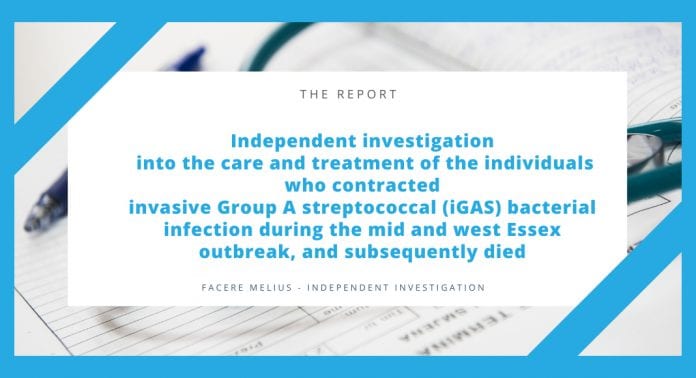
An independent investigation report into the outbreak of bacterial infection in mid and west Essex.
In the first months of 2019 a number of people in the mid Essex area became ill with the rare and contagious bacterial infection invasive Group A Streptococcus (iGAS). By March it was found to be an outbreak unprecedented in the UK. A total of 39 people were eventually treated in mid and west Essex, and 15 people died after contracting the infection. All of them lived in the area.
Public Health England (PHE) are the national body responsible for preparing for and responding to health emergencies of this kind, and they established an incident management multi-agency team in March to control the transmission of the infection, and to take measures to prevent more people becoming infected.
Group A Streptococci
Group A Streptococci (GAS) are bacteria most commonly found in the throat and on the skin, and do not usually cause illness in most healthy people, though they can cause relatively mild sore throat and skin infections. On rare occasions the bacterium can get into the body and cause severe illness – this is invasive Group A Streptococcus (iGAS).
iGAS can become potentially lethal and trigger sepsis and toxic shock. As with the current COVID-19 pandemic, it is elderly people and those with underlying health conditions or compromised immunity systems who are most at risk of contracting the infection.
In July, PHE’s microbiological testing of blood samples of people in the area who had been infected enabled them to confirm, using whole genome sequencing, the particular strain of iGAS as emm44, and confirm that 33 of the mid Essex cases were uniquely genetically linked, with six further probable cases.
That same month the Mid Essex Clinical Commissioning Group (CCG) commissioned a healthcare consultancy, Facere Melius, to conduct an independent investigation into this iGAS outbreak in their area, in line with national guidance (‘Learning From Deaths’ and ‘NHS Serious Incident Framework’). They were asked to review cases where people had subsequently died of the infection, and 24 more cases where the person infected survived the illness. In November following a pause requested by NHS England, this process was revised, and the people who had survived the infection were excluded from the investigation.
There have been no new cases of the emm44 strain of iGAS identified in mid or west Essex since August 2019.
Of the 15 people who died during the outbreak, having later been confirmed as infected by the emm44 iGAS strain, two were excluded from this Facere Melius review process, one because of lack of information, and the other because that person’s death occurred after the process had started. All 13 people whose cases were reviewed died in hospital.
The purpose of investigations carried out according to national NHS frameworks is not to apportion blame, but to review the care provided to patients who suffer harm, identify and support where learning from that care can be established, and reduce the likelihood of similar events happening again.
The first stage of the process was for Facere Melius to establish a team of specialist independent associates to review the care and treatment, in the community and subsequently after their final admission to hospital, of each of these 13 people who had become infected with the outbreak strain of iGAS.
The Facere Melius associates consulted nearly 1800 documents, including those containing medical and clinical information relating to these 13 people, and to local and national communications, minutes of meetings, reviews, policies, and guidelines. The relatives of those who had died were invited to meet with the associates or speak to them on the phone to contribute to the reviewing process. Meetings also took place with 34 members of the healthcare teams who had either been directly involved with the care of the patients who died or had a clinical leadership role in those healthcare teams.
The associates conducted further meetings, phone calls, and teleconferences, or elicited written responses, from GP services, care homes and the local ambulance service, who had all been involved in the care of this group of people.
Results
The Facere Melius senior oversight team led and co-ordinated these 13 reviews and appointed an editorial board of clinical experts to provide objective specialist support, guidance, analysis, and opinion. This board included an executive director of nursing, an executive medical director, a consultant microbiologist, a tissue viability specialist, and an infection control specialist.
By rigorously analysing and verifying all of the information they were provided with or had access to for the reviews, the associates produced draft reports that were scrutinised, assessed, and challenged by the clinical editorial board to ensure accuracy and quality. After this process, the final reviews summarised key themes and findings, supported by a chronology of events in all 13 individual cases. These were then collated into 13 ‘patient stories’, and their relatives were offered a copy when the reviews were completed.
All of these individuals (nine women and four men) who died after contracting the outbreak strain of iGAS were elderly people from the mid Essex area. They all died in the period between January and July 2019. In all but one case, they were being treated by GP practices or community nurses for wounds or skin/pressure ulcers. Some were receiving support or care for other medical needs or conditions, such as lung disease. They all had one or more additional medical conditions, known as co-morbidities. Seven were living in their own homes; six lived in care homes.
12 of this group of people died in Mid Essex Hospital Trust (now Mid and South Essex NHS Foundation Trust) – Broomfield Hospital, and one person died in East Suffolk and North Essex NHS Foundation Trust – Colchester Hospital. The length of time they spent being cared for during their final admission to hospital ranged from a few hours to nearly three weeks.
The final independent investigation report reviewed collated the main findings in the 13 reviews and subsequent patient stories. This report was also subject to rigorous clinical scrutiny by the editorial board of specialists and experts. The purpose of the report was to bring together the collective themes, findings, and opportunities to learn identified in the patient stories, and to produce recommendations for the organisations and individuals involved in the care of the patients who died, to reduce the risk of such an outbreak happening again. The patients’ identities were anonymised.
Publication of the investigation report was temporarily put on hold during the COVID-19 lockdown; it was published on 17 September 2020 (available at the Mid Essex CCG website).
It concluded that the majority of the care and treatment received by the 13 people was in accordance with best practice as formulated in local healthcare providers’ guidance. The investigation found instances in some of these cases, however, where treatment could have been more proactive, holistic, and timely. These did not indicate that the outcomes for those people would have been different.
A total of 43 examples were provided where opportunities for learning were identified and improvements in practice could be developed.
Five key themes emerged (with illustrative examples taken from the individual patient stories):
- Wound management community/hospital: local guidelines not always followed; examples found where initial holistic assessments were not undertaken; inconsistent records of the description of wound, measurement of size, photographing/tracing; wound swabs (or re-swabs) not taken when there was an indication of clinical infection; local guidelines on wound and ulcer management not up to date, and at times unclear or ambiguous
- Identifying clinical deterioration national diagnostic tools or local guidelines not consistently used; care organisations should consider how to assure themselves that continuity of care is enabled (team sizes/deployment) to maximise opportunities for early recognition of deterioration
- Antibiotic therapy lack of clarity about or accuracy of recording of allergies and drug intolerance could cause possible drug errors, or certain drugs being avoided unnecessarily; some confusion apparent about the efficacy of some non-penicillin antibiotics
- Infection prevention control (IPC): lack of clarity and consistency in community teams about what control measures they could or should have been following, and why; not always clear what, if any, personal protective equipment advisory – conflicting or unclear advice reported by care workers; communication problems; not clear how community and hospital organisations assure themselves national IPC measures are followed appropriately, especially during outbreaks – this also has some resonance during the current COVID pandemic; each organisation should review its IPC policies and outbreak plans; these should inform economy-wide plans for the area, to minimise conflict or confusion of advice/guidance
- Record keeping examples were found of incomplete or inaccurate records (in the community, care homes, and in hospital) of medical history and treatment of individuals; organisations should audit the quality of their record-keeping
The report also provided supplementary observations arising from the cases which either lay outside the scope of the investigation, or for which it had not been possible to establish a definitive view, but which it seemed important to raise for organisations to consider. These included:
- Aspects of communication and information sharing between health professionals
- Delays in taking wound swabs
- Delays in prescribing of antibiotics
- Delays in samples being delivered for analysis, and results being made available to clinicians
- Serious incidents and drug errors not being appropriately reported and acted upon
The report provides 22 implementable recommendations for Mid Essex Clinical Commissioning Group to consider. 15 relate to these key themes and a further seven focus on more general aspects of the care and treatment experienced by the 13 people.
On publication of the report, the CCG stated that a third of these recommendations have been fully implemented across the CCG, community providers, and acute services. They anticipate that implementation of or action on all the remaining recommendations will be completed by the end of the year.
No single source of transmission of this iGAS infection outbreak could be identified by the final investigation. Public Health England have subsequently informed the Facere Melius team that as a result of their epidemiological investigations and whole genome sequencing, there was evidence that people receiving community care in mid Essex were at risk of contracting the emm44 iGAS infection.
Public Health England identified the strain of Group A Streptococcus in a small number of clinical workers, and a piece of community equipment. The transmission of this particular strain is most likely to have been a result of many factors and cannot be attributed to a single individual or source.
This outbreak was found to have had a considerably stressful impact on the community nursing teams, who felt they were operating in an atmosphere of blame. They had heavy caseloads and were constrained by the infection prevention and control measures implemented by Public Health England and other organisations to contain and respond to the outbreak.
The Facere Melius team that produced the patient stories and final investigation report acknowledged that this had been a distressing time for the relatives and friends of the people who had died or been affected by the iGAS outbreak, as well as for those involved with their care and treatment.
The people who died after being infected with iGAS emm44 were all elderly, frail, and had underlying medical conditions, and this made them particularly vulnerable to any infection. Some of them, though, had still been leading active and full lives before they became seriously ill.
Many of the findings and recommendations in the published report could also inform healthcare organisations in their response to other outbreaks, such as the current COVID-19 pandemic.
Facere Melius will be publishing assurance tools to help NHS commissioners, hospitals, and local authorities assure themselves against the findings and recommendations in this report.
Learn more here: https://midessexccg.nhs.uk/news/1136-independent-investigation-report-igas







